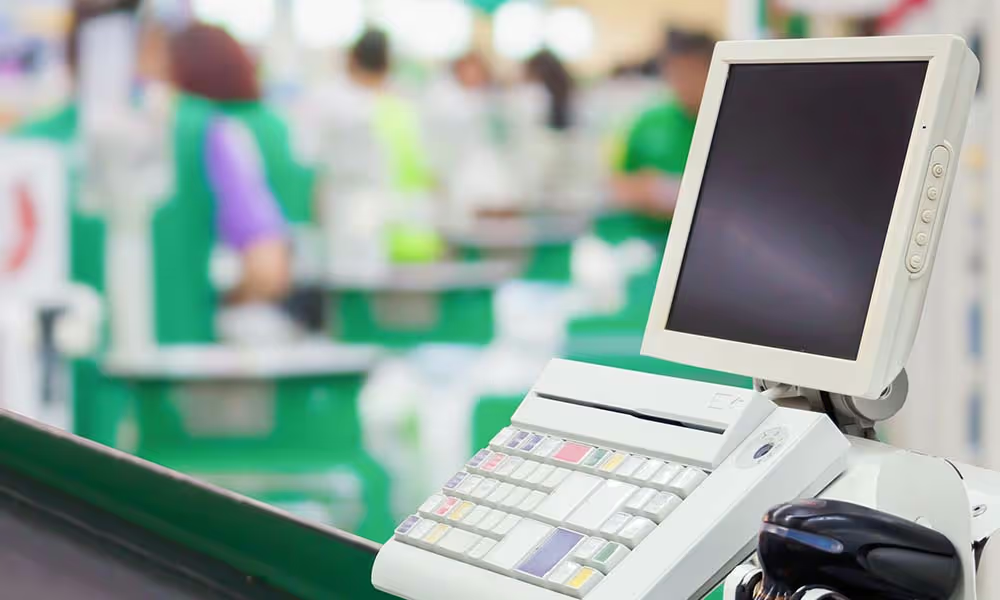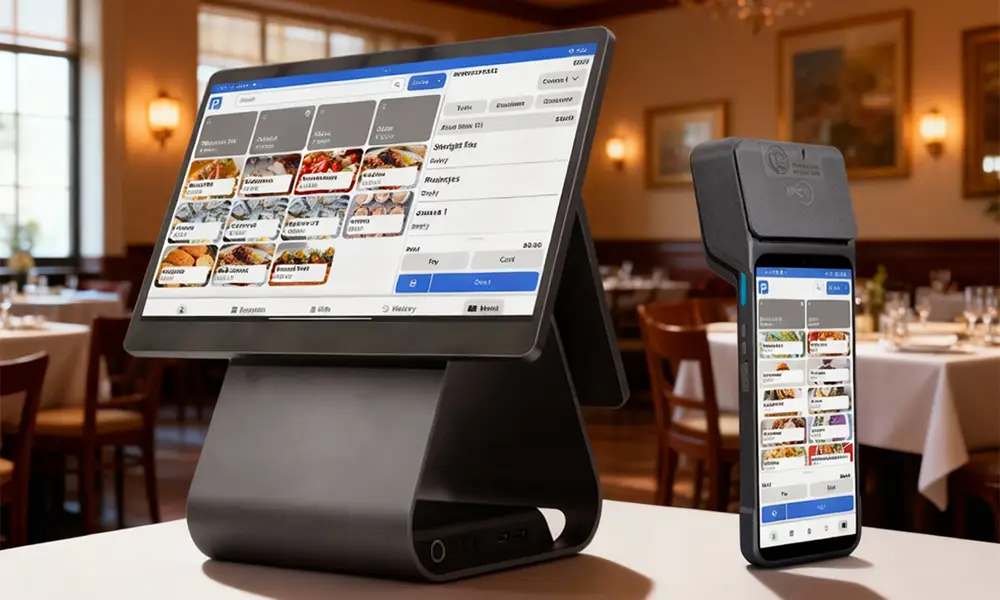Ever found yourself mid-transaction, just as your receipt printer jams, or your card reader freezes up?
Nothing derails a smooth checkout experience quite like unreliable POS hardware. But here’s the thing: with the right POS system hardware, you can prevent these headaches and keep your business running smoothly.
As a business owner, you probably already know that point-of-sale technology is crucial, but what specific hardware do you need? And, more importantly, how do you choose equipment that’s both dependable and fits your unique operations?
Let’s explore the essentials, from card readers to barcode scanners, so you can make sure every part of your POS setup is covered.
1. What Is POS System Hardware?
When we talk about POS system hardware, we’re referring to the physical components that make up a complete point-of-sale system. Think of it as everything you need to process a transaction in-store. From customer-facing screens to back-end processors, the right POS hardware setup ensures you can serve customers smoothly and securely.
Key Components of POS System Hardware
A typical POS system includes the following core pieces of hardware:
- Touchscreen Monitor or Tablet: For easy navigation of your POS software.
- Receipt Printer: To provide customers with a physical record of their transaction.
- Barcode Scanner: Speeds up checkout and ensures accurate product entry.
- Card Reader: For secure credit and debit card payments.
- Cash Drawer: To store cash securely, though it’s less common with cashless options rising.
A well-chosen set of POS system hardware will be fast, user-friendly, and designed to handle your specific business needs.
2. Must-Have POS System Hardware for Every Business
Each component in a POS system plays a unique role, and together, they create a streamlined workflow for transactions. Here’s a closer look at each must-have piece of hardware:
1. Touchscreen Monitor or Tablet
A touchscreen monitor or tablet is often the “command centre” of any POS system. It’s where your staff interacts with the POS software to process orders, view product information, and check inventory.
- Advantages: Touchscreens are intuitive, reducing training time and errors.
- Considerations: Choose a screen size that fits your space and is visible even in busy environments.
2. Receipt Printer
The receipt printer provides a quick, professional way to give customers a record of their purchase. Despite the rise of email receipts, many customers still prefer a printed copy.
- Thermal Printers: Fast and quiet, ideal for busy retail and food service environments.
- Impact Printers: Good for environments like kitchens, where high temperatures might interfere with thermal printers.
3. Barcode Scanner
A barcode scanner quickly identifies products by scanning their barcode, speeding up the checkout process and reducing human error. It’s essential for businesses with a large product catalogue.
- Wireless vs. Wired: Wireless scanners offer flexibility, while wired options are generally more affordable.
- 2D Scanners: Ideal if your business uses QR codes or more advanced barcode systems.
4. Card Reader
With so many payment options available today, a versatile card reader is a must. Look for one that supports credit and debit cards, as well as digital wallets like Apple Pay and Google Pay.
- Contactless Payments: Ensure your card reader supports NFC (Near Field Communication) for contactless payments, which are becoming increasingly popular.
- EMV Compliance: For security, choose an EMV-compliant reader to process chip-enabled cards.
5. Cash Drawer
While cash payments may be declining, a sturdy, lockable cash drawer is still essential for businesses that handle any cash. Ensure it’s sturdy, tamper-resistant, and seamlessly integrates with your POS system.
3. Additional POS Hardware to Consider for Enhanced Functionality
Beyond the basics, certain POS system hardware can elevate your service, offering a more seamless experience for both you and your customers. These may not be essential for every business but can be game-changers for specific needs.
Customer-Facing Display
A customer-facing display shows the transaction details to the customer in real-time, which builds trust and reduces errors. Many of these displays are touch-enabled, allowing customers to handle tasks like tipping or loyalty program sign-ups directly.
Kitchen Printer or Display System
For restaurants and cafés, a kitchen printer or display system is essential. It sends orders directly to the kitchen, reducing miscommunication and speeding up service.
- Kitchen Display System (KDS): A digital alternative to traditional printers, a KDS can be especially helpful in reducing paper waste and keeping orders organised.
Weighing Scales
In businesses like bakeries or grocery stores, weighing scales are a must. Make sure your POS system is compatible with the scales to streamline product pricing based on weight.
Label Printer
Label printers are especially handy for inventory management or for stores that create custom labels, like delis or packaging services.
4. How to Choose the Right POS System Hardware for Your Business
Choosing POS system hardware isn’t just about the equipment; it’s about ensuring compatibility, reliability, and meeting your specific operational needs. Here are some tips to make the best choice:
1. Consider Your Business Type
Your business type often dictates the kind of POS system hardware you’ll need. For instance:
- Retail Stores: Barcode scanners, card readers, and receipt printers are essential.
- Cafés & Restaurants: Kitchen printers and touchscreens for easy order management.
- Service-Based Businesses: Appointment scheduling displays and CRM functionality are helpful.
2. Ensure Compatibility with Your POS Software
Not all hardware works with all POS software. Check compatibility between your POS software and hardware, particularly for payment processing and inventory management features.
3. Think About Mobility
If you’re running a food truck or have limited space, mobile-friendly POS hardware like tablets or portable card readers can be a lifesaver.
4. Look for Durability and Reliability
POS hardware should be durable enough to handle constant use without breaking down. Look for equipment designed for commercial use, with warranties and customer support options.
5. POS System Hardware Installation and Maintenance Tips
Once you’ve chosen your POS system hardware, proper installation and maintenance are key to keeping everything running smoothly.
Installation Tips
- Position Hardware Strategically: Ensure screens, scanners, and other equipment are positioned for easy access.
- Secure All Connections: Prevent accidental disconnections by securing all wires and connections.
- Run a Test Phase: Before going live, test all hardware with mock transactions to identify any issues.
Maintenance Tips
- Regular Cleaning: Dust and crumbs can damage POS hardware, so keep everything clean.
- Update Software and Firmware: Regular updates can fix bugs and improve security.
- Inspect and Replace Parts: Regularly inspect equipment, especially printers and card readers, and replace parts as needed.
Final Thoughts: Make Your POS System Hardware Work for You
The right POS system hardware does more than just process transactions; it creates a seamless experience that reflects the professionalism and efficiency of your business. Whether you’re starting out or upgrading, investing in quality POS hardware can pay off in smoother operations and happier customers.
Ready to take your POS setup to the next level? Book a free demo to see how the right hardware can make all the difference in your business operations. Get your demo now!
FAQs About POS System Hardware
1. What POS system hardware do I need for a small retail store?
For a small retail store, essential POS hardware includes a touchscreen monitor or tablet, barcode scanner, receipt printer, and card reader. Additional options like customer-facing displays can enhance service.
2. How much does POS system hardware cost?
Prices vary depending on quality and features. A basic setup might start around a few hundred dollars, while advanced setups with specialised hardware can cost several thousand.
3. Can POS system hardware be used with mobile POS systems?
Yes, many hardware components are designed to be compatible with mobile POS systems, particularly tablets and portable card readers.
4. Do I need a cash drawer if I mostly accept card payments?
Not necessarily, but having a cash drawer can be helpful if your business occasionally accepts cash. If you’re fully cashless, you might not need one.
5. What’s the difference between a kitchen display system and a kitchen printer?
A kitchen printer prints order tickets, while a kitchen display system shows orders on a digital screen, often allowing for real-time updates and reduced paper waste.


%201.svg)
%201.svg)





.png)
.png)
